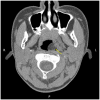An Oropharyngeal Accessory Tragus in a Young Patient With Conductive Hearing Loss
- PMID: 39735793
- PMCID: PMC11669492
- DOI: 10.1002/ccr3.70019
An Oropharyngeal Accessory Tragus in a Young Patient With Conductive Hearing Loss
Abstract
In this report, we describe the first reported case of an oropharyngeal accessory tragus in a 20-year-old female presenting with moderate to severe left-sided conductive hearing loss. This case shares rare developmental anomalies to consider when diagnosing oropharyngeal masses that highlight the intricate embryological development of the head and neck region.
Keywords: congenital abnormalities; ear; external; hearing loss; otolaryngology.
© 2024 The Author(s). Clinical Case Reports published by John Wiley & Sons Ltd.
Conflict of interest statement
The authors declare no conflicts of interest.
Figures


References
-
- Sadler T. W., Langman's Medical Embryology, 15th ed. (Philadelphia, PA, USA: Lippincott Williams & Wilkins, 2022).
-
- Hendizadeh L., Zaghi S., Guzman C., Haydel D., and Koempel J., “A Rudimentary Tragus in the Nasopharynx: Case Report, Literature Review, and Discussion of Embryologic Development,” International Journal of Pediatric Otorhinolaryngology 77, no. 8 (2013): 1378–1380, 10.1016/j.ijporl.2013.05.041. - DOI - PubMed
LinkOut - more resources
Full Text Sources

